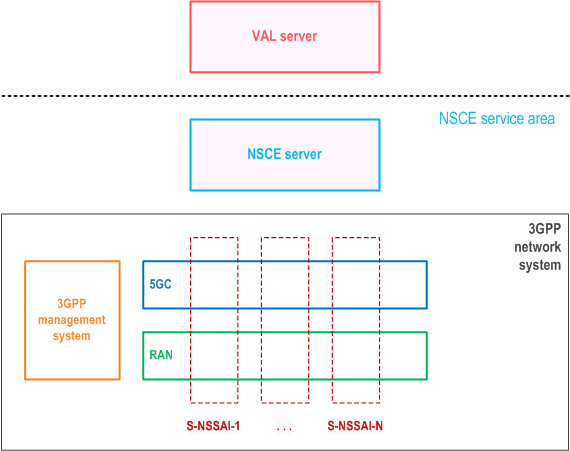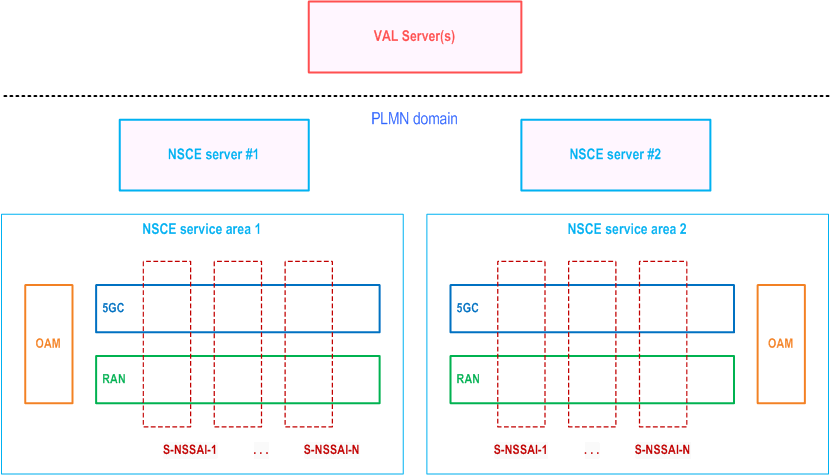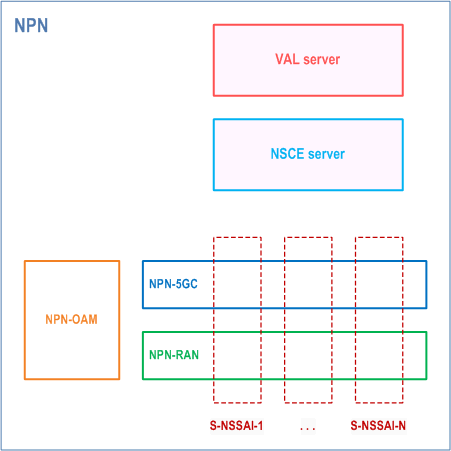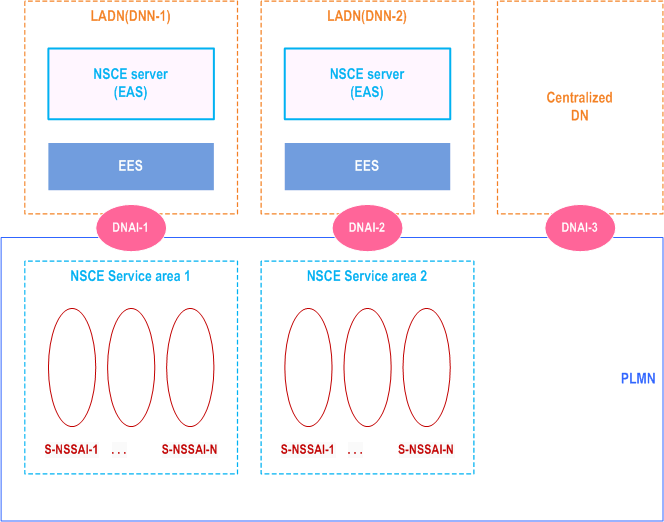Content for TS 23.435 Word version: 19.3.0
0…
4…
5…
7…
9…
9.4…
9.5…
9.6…
9.7…
9.8…
9.9…
9.10…
9.11…
9.12…
9.13…
9.14…
9.15…
9.16…
9.17…
9.18…
A…
A Deployment models
A.1 Deployment scenarios
A.1.1 General
A.1.2 Centralized NSCE deployment
A.1.3 Distributed NSCE deployment
A.1.4 NPN NSCE deployment
A.1.5 Edge NSCE deployment
A.2 Deployment of NSCE server(s) in relation to VAL server and 3GPP system
A.2.1 Centralized NSCE deployment
A.2.2 Distributed NSCE deployment
A.3 Deployment of NSCE server(s) in relation to SEAL
$ Change history
A Deployment models p. 115
A.1 Deployment scenarios p. 115
A.1.1 General p. 115
Based on the network slicing capability of the S-NSSAI granularity provided by SA2 and the network slicing capability of the NSI/S-NSSAI granularity provided by SA5, the NSCE service is provides network slicing management and control capabilities in the S-NSSAI granularity for vertical industries.
A network slice can have only one owner and one NSCE service provider. NSCE service provider and slice owner can be different. For example the slice owner is VAL server, but the NSCE service provider is MNO.
This clause describes examples of deployment models with respect to different deployment scenarios as follows.
A.1.2 Centralized NSCE deployment p. 115
Figure A.1.2 provides a example of centralized deployment of NSCE server whose service area covering the whole PLMN. It is also possible slice coverage area to be smaller than the NSCE service area.
The network slice capability enablement service is provided with the view of whole PLMN in this scenario.

A.1.3 Distributed NSCE deployment p. 116
The distributed deployment refers to the deployment model in which multiple NSCE servers are deployed by same provider, whose service area only covers some specific areas as shown below (based on geographical coordinates or TA list(s)).

When there are multiple NSCE servers managed by same provider, NSCE server(s) can be subscribed for providing the network slice statistics to another NSCE server to provide a global view.
There can be two use cases to provide the NSCE service in the distributed deployment:
One use case is that the distributed deployed NSCE is about a slice service area which is equivalent to the edge/NPN's service area. For this scenario, if the distributed deployed NSCE wants to access the NEF/NWDAF/NSACF services or to receive policies from OAM, it needs to interact to the global NSCE.
A further use case could be that some NSCE services (e.g. MnS discovery) are locally provided to VAL servers (for example as a micro-service), whereas other capabilities are provided for the whole PLMN area. So, the distributed NSCE includes a subset of capabilities which are edge native. The local deployment of such capabilities can allow for more efficient services to the VAL servers (e.g. for QoS verification, the edge deployed NSCE can receive more timely KQI/QoE measurements and can process them locally before triggering an event).
A.1.4 NPN NSCE deployment p. 116
The NSCE architecture supports the deployment that NSCE server is deployed in NPN.
Figure A.1.4 shows a deployment example of NSCE server deployment in the NPN. This case is valid if a geographical match between slice coverage area, NPN coverage area and NSCE service area is pre-configured. The matching may be pre-configured in the NSCE server by network operator based on the TA list or geographical coordinates. The NSCE server is deployed in Non-public network to provide the network slice capabilities exposure application service based on the interaction with NPN-5GC and NPN management system.

A.1.5 Edge NSCE deployment p. 117
The NSCE architecture supports the depolyment that the NSCE server is deployed in EDN as an EAS to provide the network slice capabilities exposure application service, based on the interaction with 5GS pertaining the network slice, and edge computing management system.
Figure A.1.5 shows the edge NSCE deployment cases when the NSCE server is deployed in the EDN using LADNs as described in Annex A.2.4 of TS 23.558. This case is valid if a geographical match between slice coverage area, LADN service area (which is EDN service area) and NSCE service area is pre-configured in the NSCE server. The matching can based on the TA list or geographical coordinates.

A.2 Deployment of NSCE server(s) in relation to VAL server and 3GPP system p. 118
To support the centralized/distributed deployment, the NSCE server(s) will have different deployment models and different relation with VAL server and 3GPP system.
A.2.1 Centralized NSCE deployment p. 118
The NSCE server can be deployed in single PLMN operator domain (as a SEAL server as specified in Figure 8.2.1-1 of TS 23.434), deployed in VAL service provider domain by vertical (as a SEAL server as specified in Figure 8.2.2-1 of TS 23.434), or deployed outside of both the VAL service provider domain and PLMN operator domain i.e. in 3rd party domain (as a SEAL server as specified in Figure 8.2.3-1 of TS 23.434).
The deployment of NSCE server(s), with connections to 3GPP network systems in multiple PLMN operator domains (as a SEAL server as specified in Figure 8.2.2-2) is also supported. When the vertical consumer wants to get NSCE services in two countries which are operated by two different MNOs, the NSCE service provider has to interact with two 3GPP network systems. The NSCE server is either deployed in the VAL service provider domain or deployed separately in the 3rd party domain.
A.2.2 Distributed NSCE deployment p. 118
The NSCE servers can be distributed in multiple PLMN domains (as a SEAL server as specified in TS 23.434 Figure 8.2.1-2, Figure 8.2.1-3), or distributed in single PLMN operator domain (as a SEAL server as specified in TS 23.434 Figure 8.2.1-4). The NSCE servers can also distributed in VAL service provider domain by vertical (as a SEAL server as specified in TS 23.434 Figure 8.2.2-3), or distributed deployed in 3rd party domain by 3rd party. The VAL server can communicate with multiple NSCE servers via NSCE-S as long as other NSCE servers are discovered and accessible. Or, the VAL server can communicate with other NSCE servers via NSCE-E if needed.
A.3 Deployment of NSCE server(s) in relation to SEAL p. 118
The NSCE server(s) supports standalone deployment independent with other SEAL services, it can interact with other SEAL service(s) via SEAL-X interface as specified in clause 6.2 of TS 23.434.
The NSCE service(s) supports combined deployment with other SEAL services, it can interact with other SEAL service via service API as specified in clause 15 of TS 23.434.